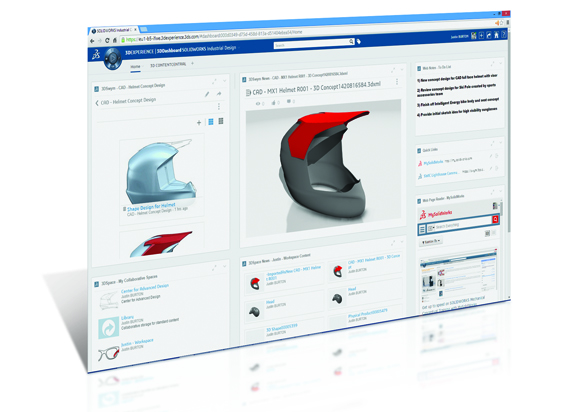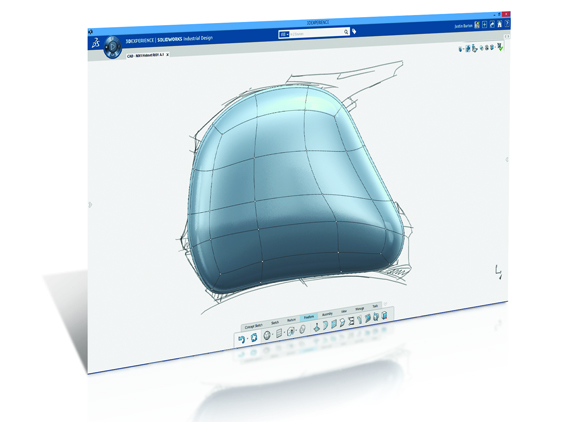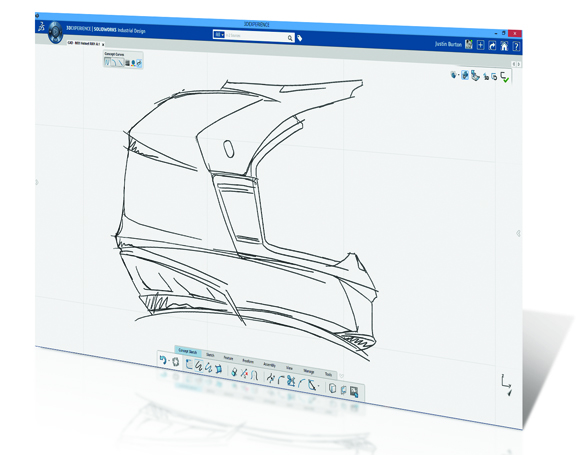
SolidWorks Industrial Design with direct access to content and community.
Latest News
February 13, 2015
 Sneak peek of SolidWorks Industrial Design with parametric input.
Sneak peek of SolidWorks Industrial Design with parametric input.Something was in the air at SolidWorks World 2015 (SWW15). It first made a guest appearance onstage on Monday, February 9, during the keynote address that marked the transition from the reign of Bertrand Sicot to Gian Paolo Bassi. Later, it remained one of the main attractions at the Partner Pavilion, hovering 4-7 ft. in the air, always watching over the foot traffic, the lunch crowd and the exhibit booths.
The aerial machine, a drone from Parrot, helped outgoing CEO Bertrand Sicot take a selfie during his farewell speech. (A photo from SolidWorks blog captured this moment.) The drone is much more than a gimmick for the opening act at SWW15. Designed in SolidWorks Industrial Design (previously called Industrial Conceptual), it represents SolidWorks’ desire to go after the fertile grounds of the IoT (Internet of Things).
The IoT race is to develop irresistible, attractive, smart devices for the general consumers, as exemplified by the health-monitor wristband Fitbit, smart home thermostat Nest and others. The elegant curves, organic shapes and complex surfaces required to meet the visual aesthetics of the consumer market is not the forte of mechanical CAD (MCAD) programs like SolidWorks. It’s usually the domain of specialized programs like Alias, Maya and Rhino, widely used by animators and industrial designers. It’s a need SolidWorks can only meet with a new product, like SolidWorks Industrial Design, a package with a mix of subdivisional and parametric modeling. The demo revealed SolidWorks Industrial Design to be a modeler that incorporates sketching in 3D planes, social media-style collaboration, online community access and control points-driven modeling.
 SolidWorks Industrial Design with sketching on 3D planes.
SolidWorks Industrial Design with sketching on 3D planes.Gian Paolo Bassi’s Balancing Act
In his debut appearance before the crowd as the new SolidWorks CEO, Bassi said, “We want to be prepared for the future, but respect the legacy.” It’s an important message to convey to those who have faithfully followed the product since its birth in 1995, the beginning of the era of Windows-based 3D MCAD programs. But in the future dominated by IoT devices and cloud-hosted software, the emphasis shifts from mechanical design to electrical design, embedded software and system-level simulation. Bassi must devote R&D muscles to address the emerging trends without losing sight of the company’s flagship software and the company’s namesake, SolidWorks. He has a difficult balancing act.
During his keynote address, Bassi introduced the new product SolidWorks Industrial Design as “a product for the cloud generation.” The demonstration also included running the software from a browser.
Later, fielding questions from the press, he described the technology behind the program as “hybrid,” because the product “still requires local installation” but relies on “cloud integration for social collaboration.” It wouldn’t be pure cloud like Facebook, which you cannot use without connectivity, he explained, because “using the software without being connected is still a value for the customer.”
The integration of sensors, chips and embedded software demand a closer working relationship between mechanical and electrical disciplines, made possible by smooth data exchange between the two. For designing basic electrical schematics, the company offers SolidWorks Electrical. Dedicated 2D/3D electrical CAD (ECAD) programs come from partnerships with vendors like Altium, which offers PCBWorks for SolidWorks users.
“Collaboration issues between ECAD and MCAD workflows have always been a thorn in the side of engineering teams,” said Jason Hingston, CTO at Altium. “PCBWorks dramatically shifts the landscape of how electronic and mechanical engineers work together, making the design process virtually seamless between ECAD and MCAD teams.”
 SolidWorks Industrial Design with direct access to content and community.
SolidWorks Industrial Design with direct access to content and community.Using Big Data to Build a Predictive Modeler
Another futuristic outlook is to explore predictive computing in SolidWorks products, a project shepherded by Rich Chin, the company’s director of product innovation. During installation, SolidWorks users have the option to voluntarily participate in the data collection to improve the software. The cumulative data spanning a decade has no identifying data but only user behaviors (for example, the frequency with which someone uses a particular modeling tool, time spent modeling and so on), Chin clarified.
“It’s well over a terabyte of data, representing about three releases of SolidWorks,” Chin said. “We just hired a data-mining company so clean it up and start analyzing it.” The two immediate goals for the project, Chin explained, are (1) to have a better understanding of the different user segments based on expertise, time spent in the software, type of commands used and the percentage of the product leveraged; and (2) to develop Amazon-style feature recommendations based on usage behavior studies.
“SolidWorks is a comprehensive product, used in many industries,” Chin said. “A lot of our customers only use a small portion of the product. This project is about helping you discover the parts of SolidWorks that are relevant to you.”
Bassi gives a hint at the long-term objective when he said in his keynote, “We need a platform that can make sense of big data ... we’d like to use the power of predictive computing, or AI (artificial intelligence) that can suggest solutions.”
In the following day’s keynote, Dr. Michio Kaku, a theoretical physicist and futurist, ushered SWW15 attendees into a brave new (and somewhat unsettling) world, where true memories can be captured and shared, false memories can be implanted and machines attempt to replicate the functions of the human brain. That’s for another day, coming in another blog post about SWW15.
Drone attacks editor at #SWW15 ! :P pic.twitter.com/XpSP5llXzR— KennethwongSF (@KennethwongSF) February 10, 2015
Subscribe to our FREE magazine, FREE email newsletters or both!
Latest News
About the Author
Kenneth Wong is Digital Engineering’s resident blogger and senior editor. Email him at [email protected] or share your thoughts on this article at digitaleng.news/facebook.
Follow DE





